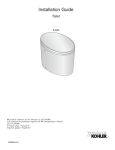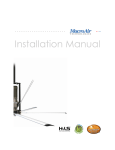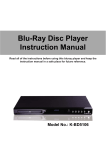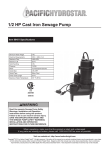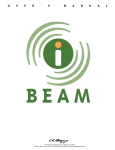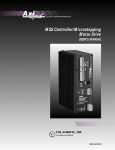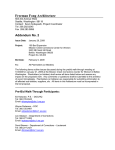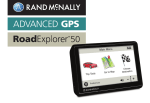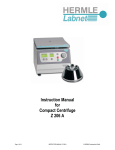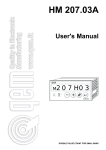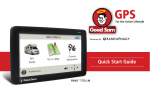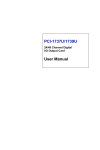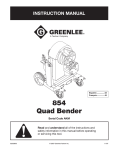Download NTCIP 9003-Amendment 1 v04
Transcript
NATIONAL TRANSPORTATION COMMUNICATIONS FOR ITS PROTOCOL CASE STUDY REPORT NTCIP 9003-Amendment 1 v04 Washington State DOT NTCIP VMS Software Upgrade Amendment 1 version 04, January 2003. A Recommended Information Report of the Joint Committee on the NTCIP. © 2003 AASHTO / ITE / NEMA. All rights reserved. Permission to copy without fee all or part of this Information Report is granted for the following noncommercial use, without editing or modification: (a) downloading the electronic file, and making up to 30 copies of the file by electronic mail distribution or disk reproduction; (b) printing one copy, and reproducing and distributing up to 30 printed copies; and (c) excerpts limited to 5 or fewer pages. Provided that all the foregoing use includes the © AASHTO / ITE / NEMA copyright notice; along with a notice that the copy is reprinted with permission; and along with the title, document number, and date; all of which appear on each copy. Permission is not granted for the following use: (i) republishing in compendiums or anthologies; (ii) publishing excerpts in commercial publications or works for hire; (iii) display in electronic storage devices or methods on networks; and (iv) in translations to other languages. Other use requires prior written consent; see the Request form in the www.ntcip.org Library. PREFACE When early adopters began using the NTCIP in their deployment activities, there was limited guidance available. Since then, The NTCIP Guide (NTCIP 9001) has been developed to help users understand, specify, and deploy the family of standards. NTCIP 9001 version 03 was completed in 2002 and is available. Early NTCIP deployments and the initial NTCIP case studies identified issues due to content ambiguities and shortfalls in the first version of several standards. Subsequent amendments addressed many of these issues. Case study reports revealed that functional requirements within user specifications could be improved. As a result, a systems engineering approach to standards development has been adopted to help users better specify NTCIP-based systems. New versions of ITS standards will add sections on concepts of operation, functional requirements, traceability to the data dictionary, and dialogs and sequences. Early adopters also revealed that testing was an issue in many of their deployments. An NTCIP working group on testing and conformity assessment was created in 2002 to further assess and define testing issues. The case studies also revealed a general need for continued outreach, education and training. These needs are being addressed through a variety of ongoing Standards Development Organization activities. These NTCIP case studies have proved valuable to the ITS community and have facilitated the continued improvement of the standards. As a result of lessons learned from the case studies, and improvements in the standards development process, future deployments are expected to face fewer challenges. Page 1 of 3 NTCIP 9003 Amendment 1 - v04 NTCIP Case Studies VDOT Statewide VMS Project 1. CASE STUDY UPDATE The initial deployment of NTCIP-conformant equipment by the Washington State Department of Transportation (WSDOT) was documented in a case study of their Variable Message Sign (VMS) implementation in NTCIP 9003 Version 01.04, dated September 29, 1999. Now that some time has elapsed since that initial effort, AASHTO, FHWA, ITE, and NEMA are sponsoring this case study update. This effort, presented as a case study amendment, focuses on insights gained over the three years of deployment since the initial case study was performed. Specifically, this Amendment will address Agency issues concerning current implementation efforts and needs based upon experience gained through NTCIP deployment experience. 2. RECENT NTCIP IMPLEMENTATION EFFORTS The original WSDOT NTCIP VMS Software Upgrade Project incorporated three variable message signs into the Seattle Freeway Management System (FMS). These signs were deployed using a multi-drop communications infrastructure (Null/PMPP, also known as Class B); a separate contract was let to develop an NTCIP-conformant device driver for their central system. The Agency has since procured an additional 16 NTCIP-conformant signs under eight separate contracts. All 16 of the new signs use multi-drop communications (Null/PMPP). The signs were acquired from four separate manufacturers and then integrated into the FMS. 2-1 CURRENT PROCUREMENT PRACTICES Signs are typically procured as a part of a larger construction project, of which the procurement of a sign is only a small part. In order to ensure that the signs meet agency requirements, the Agency requires the prime contractor to select products from a “Qualified Products List.” The Agency has significantly enhanced its testing process. It now performs pre-qualification testing using the NTCIP Exerciser and a customized version of the ENTERPRISE Test Procedures, using its in-house NTCIP experts. The customization to the Test Procedures was designed to focus the testing on only those features that are used by the Agency; the Agency recognizes that most vendors claim support to many other features, but these are not tested as a part of the pre-qualification process. The Agency has pre-qualified four manufacturers and has had a fifth express interest in being pre-qualified. 2-2 CURRENT SPECIFICATION CHANGES In the original project, the deployment was largely experimental and there were no formal NTCIP specifications prior to the initiation of the project. The Agency has since developed a set of NTCIP specifications as shown in Annex A. Individual projects may modify these base specifications in order to reflect project-specific requirements (e.g., sign size, etc.), but most deployments now use these specifications as a starting point. 3. FUTURE NEEDS Based upon their experience to-date, the Agency believes that NTCIP provides both interoperability and interchangeability for message signs. Previously, they required conformance to the one proprietary protocol supported by their central system, which effectively resulted in a single manufacturer providing signs. By implementing the NTCIP within their system, they have developed a competitive market for their signs and realized a cost savings in sign procurement. Page 2 of 3 NTCIP 9003 Amendment 1 - v04 NTCIP Case Studies VDOT Statewide VMS Project Several users have requested improved functionality and feature sets in the NTCIP standards. However, WSDOT is satisfied with the current feature set offered by the standard. Their central system uses only a subset of what the standard defines and what most vendors have implemented. Overall, the agency has a favorable opinion of the state of the NTCIP standards related to message signs. While there were some growing pains in the initial project, the standards are now more mature and agencies and vendors are now more experienced with these standards. As a result, they experience fewer headaches when trying to deploy new equipment within their system. The Agency is also beginning to use the NTCIP for environmental sensor stations (ESS). These systems, however, are being deployed by other divisions of the Agency and those interviewed as a part of this case study were not aware of any details of these deployments. Page 3 of 3 NTCIP 9003 Amendment 1 - v04 NTCIP Case Studies WSDOT VMS Specifications Annex A – Project-Specific NTCIP Items ANNEX A: WSDOT VMS SPECIFICATIONS The following contains complete versions of the generic WSDOT procurement specifications for Dynamic Message Signs. Parties interested in additional information should contact Mr. Mark Morse with WSDOT at (206) 440-4479. ************************************************************************************************************************ ITSVMSQUAL.DT1 (NWR May 6, 2002) VMS Manufacturer Eligibility Process The Manufacturer Eligibility requirements herein are to ensure manufacturers have adequate experience and have been keeping up-to-date on the latest communication technology for VMS. Any manufacturer successfully qualifying under this contract will be required to conform to all specification requirements and pass all acceptance tests as listed in these Special Provisions. The Contractor-provided VMS Manufacturer must complete this Eligibility Process prior to submittal of materials or shop drawings. Qualification Information Prior to or at the pre-construction conference, the applicant shall submit qualification information to the Project Engineer to show conformance to the following requirements: 1. Applicant shall have at least five (5) years of experience in the manufacture of LED technology VMS used as permanent traffic control signs on highways. The applicant may use the experience of a subsidiary company in meeting this requirement provided the applicant is a participant in the manufacturing process. 2. Applicant shall provide all past customer references for the years 1996 through 2001 where they have provided LED technology VMS used as permanent traffic control signs on highways. These references shall be from the owning agency of the signs and shall include the owning agency’s name, contact person’s name, contact person’s title, address and phone number along with details on the VMS that were provided to each jurisdiction. These references will be contacted by the Contracting Agency to determine, but may not be limited to, the performance and quality of the variable message signs provided from the manufacturer as determined by the owner. The Contracting Agency will determine successful qualification by using predetermined selection criteria. 3. Applicant shall provide a sign simulator test package. The test package shall contain an executable computer program that operates on the Microsoft Windows (95,98,NT,2000) computer platform. The software shall simulate the operation and communications between the new sign(s) and the Contracting Agency’s central VAX computer. The connection between the simulator and the VAX computer will be EIA-232 at 1200 bits per second and conform to the NTCIP standards as specified in this contract. The software shall be provided on CDROM or 3.5 inch diskettes. Operating instructions shall be included and contain the contact information for the manufacturer’s support engineer. The qualification information shall be submitted in a sealed envelope, which shall be prominently identified as VMS MANUFACTURER ELIGIBILITY. On the letter transmitting the submittal shall be the submitted date, the name and address of the submitting company and the specific individual [with mailing address, if different than above, telephone number and email address (if available)] to be contacted relative to matters in the submittal. Page A-1 NTCIP 9003 Amendment 1 - v04 NTCIP Case Studies WSDOT VMS Specifications Annex A – Project-Specific NTCIP Items The acceptance of the Manufacturer Eligibility Application does not in any way constitute that the applicant has met the requirements of the eligibility and may be rejected based on the review of the information submitted. The Contracting Agency may, at its sole discretion, contact any of the applicants during the evaluation process for clarification of any entries in the application and/or request additional information supporting any clarification offered. Such clarification and additional information shall be submitted along with the completed Affidavit of Accuracy form to the Engineer in writing no later than five (5) business days after the Contracting Agency’s request. Contacts made by the Engineer to the applicants will be made between the hours of 8:00 AM and 5:00 PM PST. The Contracting Agency may deny the manufacturer if any of the following conditions apply: 1. The manufacturer does not indicate the appropriate experience as stated in this solicitation. 2. The references provide information that causes the applicant to not successfully qualify under the established criteria. 3. The applicant fails to provide the Engineer within the required time frame any additional information requested as stated previously. 4. The Engineer determines that the manufacturer fails to provide a complete list of their past customer references for the years 1996 through 2001. 5. The Engineer determines that the provided software sign simulator is incompatible with the Contracting Agency’s VAX computer. The application submittal shall include clear and concise documentation to demonstrate the applicant is qualified, however the submittal shall be limited to ten (10) pages exclusive of the customer reference list. Qualification information shall only include that information needed to show conformance to the requirements herein. No additional explanation or information shall be submitted. ITSVMS1.DT1 (NWR February 11, 2002) Description Section 8-20.1 is supplemented with the following: This work shall consist of furnishing, installing and testing all materials and equipment necessary to complete in place the variable message sign system, and when specified, the modification of such an existing system. ITSVMS2.DT1 (NWR February 11, 2002) Materials Section 9-29 is supplemented with the following: Sign Display The sign display shall be a continuous matrix of pixels, 27 pixels high and 105 pixels wide. Each pixel shall be made from a grouping of amber light emitting diodes and contain no moving parts. The matrix of pixels shall be capable of displaying a message of 3 lines of text, 18 characters long. The sign display and other associated Page A-2 NTCIP 9003 Amendment 1 - v04 NTCIP Case Studies WSDOT VMS Specifications Annex A – Project-Specific NTCIP Items VMS components shall permit a test message using all 2,835 pixels, running at the maximum brightness and 100 percent duty. VMS Sign Beacon Three flashing beacons shall be installed on top of the sign housing. The beacons shall be as specified in Section 9-29.21. The 12 inch lamps shall be LED type, amber in color and meet the applicable portions of Section 9-29.16(2)A. The beacons shall be aluminum and consist of single section, 12 inch traffic signal heads with cadet visor, square doors, and amber display. The center beacon shall flash alternatively to the two outside beacons. Controllers for flashing beacons shall be as specified in Section 9-29.15, with aluminum sheet metal cabinets. The sign controller shall operate the beacons as commanded by the NTCIP communications protocol. Sign Housing The VMS housing shall provide walk-in service access for all LED display modules, electronics, power supplies, environmental control equipment, air filters, wiring, and other internal VMS components. The internal size of the housing shall be a minimum of 6 feet high. The access doors shall be a minimum of 2 feet wide by 6.5 feet high. The nominal external dimensions of the sign shall not exceed 25 feet in width, 8 feet in height, and 4.25 feet in depth. The VMS back and side housing walls shall be vertical. The front VMS wall shall be built at an angle of 3 degrees toward the viewing motorists. Display modules shall be parallel to the front VMS wall, so that use of the LED viewing cone is optimized. The dead load of the housing and contents shall not exceed 3750 lbs. VMS housing exterior sheet material shall be aluminum alloy number 5052-H34, and shall have a minimum thickness of 0.125 inches. Exterior sheet seams shall be continuously welded and waterproof. VMS housing structural frame members (Ibeams, C-channels, Zee-extrusions, and bar stock) shall be aluminum alloy number 6061-T6. The minimum distance from the interior rear wall of the VMS housing to the closest display components shall be 36 inches. This free space shall be maintained across the entire interior of the sign housing, with the exception of structural members. Structural members shall be designed and positioned so as to not be an obstruction to free movement of maintenance technicians throughout the interior of the housing. Circuit boards/display components shall be protected from accidental contact by maintenance personnel. VMS housings shall be constructed to present a clean, neat appearance, and the equipment located within shall be protected from rain, snow, dirt, and corrosion. Sign housing floors shall contain small weep holes for draining water that accumulates due to condensation. Weep holes shall be fabricated in a manner which prevents the entrance of insects. The front of the LED display matrix shall be completely covered with polycarbonate sheeting that is weather tight, ultraviolet (UV) light protected, non-glare, and which has a minimum thickness of 0.17 inches. To achieve maximum display contrast and legibility, the outside of the polycarbonate sign face shall be fully covered with a mask, which is formed from aluminum sheeting. The mask shall have a minimum thickness of 0.09 inches and shall contain a circular opening for each pixel. The openings shall not hinder the 15° LED viewing angle. All exposed metal on the VMS front face, which is visible to viewing motorists, shall be coated with black Kynar 500 resin or an equivalent oven-fired fluoropolymer-based coating having a minimum outdoor service Page A-3 NTCIP 9003 Amendment 1 - v04 NTCIP Case Studies WSDOT VMS Specifications Annex A – Project-Specific NTCIP Items life of 20 years. This shall include the aluminum face mask, the aluminum border outside the LED display matrix, and all the mounting and assembly hardware. The VMS housing shall include a minimum of two (2) NEMA 20-R, 120 VAC duplex electrical outlets, with ground-fault circuit interrupters. One duplex outlet shall be located at each end of the inside of the VMS housing. The VMS housing shall contain one (1) 4 foot, 40-watt fluorescent lamp for every 5 feet of VMS housing length. Lamps shall be evenly spaced across the inside roof of the VMS housing, so they can provide uniform light distribution for night time maintenance purposes. Fluorescent light assemblies shall be covered with a protective wire cage. Fluorescent light ballasts shall be rated for operation at 0°F. The fluorescent light circuit shall be controlled by a manual timer switch having an adjustable on time of two (2) hours. All VMS equipment, components, modular assemblies and other materials located within the VMS housing shall be removable, transportable, and capable of being installed by a single technician utilizing a one-person aerial lift truck. VMS structural members are not included in this requirement. The interior VMS environment shall be monitored and controlled by the sign controller. Environmental control shall be designed to maintain the internal VMS temperature at or below +140°F when the outdoor ambient temperature is at or below +115°F. The VMS environmental control system shall consist of four primary subsystems as follows: Internal Temperature Sensors - The VMS shall contain two internally-mounted temperature sensors which are equipped with external thermocouples and which the sign controller continuously monitors. This temperature information shall be used by the sign controller to determine when to activate and deactivate the environmental control systems described herein. Sensors shall be located on opposite ends of the upper 1/3 of the LED display matrix, and their external thermocouples shall be attached to and make contact with an LED pixel circuit board. The thermocouple and LED board shall be easily detached, in the event that one of the units requires removal and replacement. Sensors shall be capable of measuring temperatures from -40 to +185°F. The sign controller shall automatically shut down the LED display whenever one or both sensors indicate that LED board temperature has exceeded +140°F. The sign controller shall automatically restart the LED display whenever the suspect temperature falls below +130°F. Both shutdown and re-start temperature thresholds shall be userprogrammable. Sensor temperatures and VMS shutdown/re-start events shall be reportable to the VMS Central Software. Housing Cooling System - The VMS housing shall contain a cooling system, which circulates outside air into the VMS housing whenever LED board temperature exceeds a user-programmable threshold. This system shall consist of enough ventilation fans as needed to exchange the internal VMS housing air volume at a minimum rate of 3.8 times per minute. Fans shall be the ball-bearing type. Exhaust fans shall be mounted in a line across the upper rear wall of the VMS housing and shall direct air out of the cabinet. There shall be one filtered air intake port for each exhaust fan. Intake ports shall be located in a line across the lower rear wall of the VMS housing. Intake ports shall contain a removable filter, which shall remove airborne particles measuring 500 microns in diameter and larger. The sign controller shall initially be programmed to activate the VMS housing cooling system whenever the LED board temperature exceeds +100°F and will turn the cooling system off whenever LED board temperature falls below +95°F. On the VMS housing rear exterior wall, all air intake and exhaust ports Page A-4 NTCIP 9003 Amendment 1 - v04 NTCIP Case Studies WSDOT VMS Specifications Annex A – Project-Specific NTCIP Items shall be covered on their top, front, and sides by an aluminum shroud fabricated from 0.090 inch aluminum sheeting. Shrouds shall be securely fastened to the VMS housing, and all shroud-to-housing interfaces shall be thoroughly gasketed to prevent water from entering the VMS. All air filters and fans shall be removable from inside the VMS housing. The VMS housing cooling system shall be controllable by an adjustable timer that will turn fans off after the set time has expired. The timer shall be adjustable to at least four (4) hours, and it shall be located just inside the VMS housing door, within easy reach of a maintenance technician standing outside the VMS doorway. LED Display Cooling System - The VMS shall contain an LED display cooling system, which directs air across the LED display modules whenever LED board temperature exceeds a user-programmable threshold. This system shall be comprised of fan-forced air directed vertically across the back side of the entire LED display matrix. The air source shall consist of multiple ball-bearing fans. The sign controller shall initially be programmed to activate the LED cooling fan system whenever LED board temperature exceeds +110°F and shall deactivate the system whenever LED board temperature falls below +105°F. Cooling fans shall be located so as not to hinder removal of LED display modules and driver boards. Front Face Panel Defog/Defrost System - The VMS shall contain a defog/defrost system which circulates warm, fan-forced air across the inside of the polycarbonate front face whenever LED board temperature falls below a userprogrammable threshold. The air source shall consist of multiple ball-bearing fans that provide uniform airflow across the polycarbonate face panel. The sign controller shall initially be programmed to activate the defog/defrost system whenever LED board temperature falls below +40°F and shall deactivate the defog/defrost system whenever LED board temperature exceeds +105°F. A 100-watt pencil-style heating element shall be mounted in front of each defog/defrost fan and shall serve to warm the air directed across the VMS face. Heating elements shall be on only when the defog/defrost fans are on. Sign Mounting Hardware A VMS, sign structure, foundation, and a maintenance walkway are included in the construction. The sign housing shall be provided with all necessary hardware including sign mounting beams, vertical and horizontal brackets, maintenance walkways, and all related hardware to install the VMS. The maintenance walkway shall be a minimum of 5 feet wide measured from the face of the sign, and equipped with a folding handrail on the front of the walkway and either a safety chain or rail between the handrails. The walkway shall extend from the nearest edge of the pavement to 5 feet beyond the opposite end of the sign. A 5 foot platform shall be provided on both ends of the sign housing to service the access doors. The walkway shall be level with the bottom edge of the VMS. All mounting hardware shall be hot-dip galvanized or stainless steel and shall conform to the G series Standard Plans, the Standard Specifications and the Plans. All nuts used in the mounting hardware shall be self-locking nuts with nylon inserts. The VMS housing, structural framing, face covering, and mounting members shall be designed to withstand a wind velocity of 100 mph with a 30 percent gust factor and shall otherwise comply with the latest requirements of AASHTO’s Standard Specifications for Structural Supports for Highway Signs, Luminaries and Traffic Signals. ITSVMS2A.DT1 Page A-5 NTCIP 9003 Amendment 1 - v04 NTCIP Case Studies WSDOT VMS Specifications Annex A – Project-Specific NTCIP Items (NWR February 11, 2002) Ground-mounted VMS Field Cabinet The field cabinet shall contain the equipment shown in the Plans. The cabinet shall have the same external dimensions and appearance of Model 334 cabinets as specified in Chapter 12 of FHWA IP-78-16. The cabinet shall contain the main power feed from the 120/240v transformer. 1. Cabinets shall be fabricated of 0.125 inches sheet aluminum, 5052 alloy, with mill finish, in accordance with Section 9-29.13(7)D, Item number 1. Painted steel or aluminum is not allowed. 2. Cabinet doors shall have a three-point latch and two-position stop assembly with spring-loaded construction core lock capable of accepting a Best Lock Company 6-pin CX series core. The Contractor shall supply red construction cores with two master keys and one core key per lock. The Contractor shall deliver the keys to the Engineer. 3. The cabinet shall be equipped with an electric strip heater and a ventilation fan. The strip heater shall be rated at 100 watts and 120 VAC and be shielded in a manner that prevents damage to nearby electrical cables. The ventilation fan shall be mounted in the top of the cabinet, be equipped with a screened guard, and exhaust at least 80 gallons per minute. The fan and strip heater shall be controlled by a high-low adjustable thermostat, which can be set to ensure the cabinet interior temperature remains between 60°F and 120°F. 4. Two shatterproof fluorescent interior cabinet lights with self-starting ballast shall be furnished, one fixture mounted on the rear rack near the top and the second mounted at the top of the front rack. Door switches shall automatically turn on both lights when either door is opened. 5. The cabinet shall be provided with two 15 amp, 120 VAC duplex receptacles. One of the receptacles is for a laptop and/or tools and shall be GFCIprotected. The second receptacle is for communications equipment and shall not be GFCI-protected. 6. The cabinet shall be provided with three (3) circuit breakers. One circuit breaker shall be rated at least 20 amps and shall operate the heater, ventilation fan, receptacles, and lamps. The second circuit breaker shall be two-pole and control the power to the VMS defog/defrost heater elements. The third circuit breaker shall operate all other sign equipment. The second and third circuit breakers shall be rated in accordance with the NEC. Separate terminal strips shall be provided for each circuit breaker and an unfused terminal for the neutral side of the power supply line. 7. The cabinet shall be provided with two serial communication ports. One communication port shall be used to connect a laptop to the controller. The interface shall be wired as a 9-pin, EIA-232 DCE port. The port shall connect to a laptop computer using a straight-through 9-pin cable. One cable shall be supplied for each VMS installed in this contract. The second communication port is for remote control of the sign from the central computer. The interface shall be wired as a 25-pin, EIA-232 DTE port. This port connects to a communication interface (modem) specified elsewhere in this contract. A cable shall be supplied to connect the VMS Page A-6 NTCIP 9003 Amendment 1 - v04 NTCIP Case Studies WSDOT VMS Specifications Annex A – Project-Specific NTCIP Items communication port to the modem port (the modem port may be a nonstandard pin-out and require a custom-made cable). 8. A reset button shall be provided in the cabinet that, when pressed, resets the VMS controller and all other VMS electronics. 9. A pullout shelf shall be provided in the cabinet to facilitate a laptop during local testing and control of the VMS. 10. Noise and voltage spike protection shall be provided in the cabinet as stated in the Transient Current Protection section of the Contract Provisions. 11. The conductor within the cabinet and the sign shall meet the requirements of Section 9-29.24. The conductors for communication shall be a minimum of 22 gauge. ITSVMS2B.DT1 (NWR February 11, 2002) Control System The VMS control system shall include all excavation, backfill, conduit, wiring, and all hardware associated with providing power and communication between the local control cabinet and the sign. It shall also include writing, providing, and installing all software and any needed hardware to ensure the VMS is fully compatible with and completely capable of being operated by the Contracting Agency's existing Digital VAX computer system, while requiring no additional software or software modifications to be installed in the Contracting Agency's VAX. Circuit Boards The manufacturer’s submittal shall include a schematic diagram for each type of circuit board used in the sign display and control system. Each circuit board used in the VMS display and control system shall conform to the following: 1. The printed circuit board through-hole for each LED cathode lead shall be connected to a large copper trace pad having a minimum surface area of 25 square millimeters. The trace pads shall dissipate heat from the LEDs and shall be present on both the front and rear sides of the LED pixel board. 2. All exposed metal (except connectors) shall be protected from water and humidity exposure by a thorough application of acrylic conformal coating. Bench level repairs to individual devices, including discrete LED replacement and conformal coating repairs, shall be possible. 3. Printed circuit laminate shall be FR-4 fiberglass, having a minimum thickness of 1.5 millimeters. The circuit board traces shall be copper. Through-holes shall also be plated with copper. 4. All cables attaching to circuit boards shall be held in place by locking latch connectors that firmly hold the cables in place. Display LEDs LEDs used in the VMS display shall be from one LED manufacturer and of one part number. LEDs shall conform to the following minimum requirements: 1. Page A-7 LEDs shall be un-tinted, non-diffused, high-output, solid state lamps utilizing Indium Gallium Aluminum Phosphide (InGaAlP) technology. The LED manufacturer shall be Toshiba or Hewlett-Packard. NTCIP 9003 Amendment 1 - v04 NTCIP Case Studies WSDOT VMS Specifications Annex A – Project-Specific NTCIP Items 2. The discrete LEDs size shall be T 1-3/4. LED package style shall be the through-hole flush-mount type, and all LEDs shall be soldered with the base of their lens mounted within 0.25 millimeters of the printed circuit board. 3. LEDs shall emit amber light, having a peak wavelength of 590 ± 5 nanometers. The half-life rating shall be 100,000 hours. Rated brightness per LED shall be a minimum of three (3) candelas. 4. LEDs shall be pre-sorted by the LED manufacturer for luminous intensity and color. LEDs used shall be obtained from a one-bin luminous intensity sort. A bin is defined such that when all LEDs from a given bin are driven with an identical forward current, the dimmest LED shall emit no less than half the luminous intensity of the brightest LED in the bin. 5. Operating temperature range shall be -30 to +85° C, and storage temperature range shall be -40 to +120° C. 6. Minimum half-power viewing angle shall be 15°. Half-power viewing angle is defined such that, at a given distance from the LED, luminous intensity measured at any point at an angle of 7.5° from the LEDs center axis shall be no less than half the luminous intensity measured directly on the LEDs center axis. 7. The discrete LED manufacturer’s data sheet showing compliance with this Special Provision, and 10 samples, shall be provided with the VMS manufacturer’s submittal. LED Modules The VMS shall be constructed with multiple display circuit boards, each of which contains no less than five (5), but no more than forty-five (45) pixels. Each pixel, which is defined as the smallest programmable portion of a display matrix, shall consist of a cluster of closely spaced discrete LEDs (strings of LEDs) and shall conform to the following requirements: Page A-8 1. The distance from the center of one pixel to the center of all adjacent pixels, both horizontally and vertically, shall be 66.0 millimeters. 2. Each LED string shall be in series with its own current limiting resistor. Current limiting resistors shall be rated to limit LED string forward current to 30 milliamperes whenever a forward voltage is applied. 3. Each pixel shall contain a minimum two (2) string of LEDs. Each LED string shall contain a minimum six (6) LEDs. 4. The failure of an LED string shall not cause a change in the forward current of any other LED string, nor shall it cause the failure of any other LED string. Similarly, the failure of any LED pixel shall not cause the failure of any other pixel in the VMS. 5. Each LED pixel shall emit a minimum luminous intensity of 40 candelas when driven with a forward current of 20 milliamperes DC per LED string. An independent laboratory that utilizes equipment and procedures traceable to N.I.S.T. standards shall certify LED pixel intensity. The independent laboratory’s certification report shall be provided with the VMS manufacturer’s submittal. This report shall contain the laboratory name, address, and contact information. The report shall also contain a description of the test procedure and test equipment used, test personnel name(s), pixel intensity test results, NTCIP 9003 Amendment 1 - v04 NTCIP Case Studies WSDOT VMS Specifications Annex A – Project-Specific NTCIP Items date(s) the VMS manufacturer’s LED pixel samples were tested, and the VMS manufacturer’s name. 6. Discrete LEDs shall be mounted perpendicular to their PC boards. Any variations in discrete LED color and intensity shall be thoroughly dispersed throughout the entire display, thereby creating a uniform visual appearance of both color and intensity. 7. The sign controller shall be able to measure the forward current of each LED pixel and determine if the pixel is operating normally. This information shall be stored in a read-only NTCIP object. LED Output Control The LEDs shall be driven using Pulse Width Modulation (PWM) of a nominal 30 milliampere forward current, where pulse width is used to achieve the programmed LED intensity level for a given ambient lighting condition. The current pulse shall be modulated from a 10-millisecond period, and pulse amplitude shall not be allowed to exceed 30 milliamperes per LED string. An illustration of the PWM drive current waveforms, which are used to achieve minimum and maximum LED intensity, shall also be provided with the VMS manufacturer’s submittal. LED Intensity Control System The VMS shall be equipped with an LED intensity control system. The control shall support both manual and automatic control. LED intensity control shall consist of three (3) photo-sensors and associated circuitry. VMS controller analysis of these ambient light measurements shall automatically determine which of sixteen pre-programmed LED intensity levels will provide the best VMS legibility for the given ambient light condition. The LED intensity control system shall not cause flickering of the LED display. The LED intensity control system shall conform to the following minimum requirements: 1. The VMS controller shall contain a read-write NTCIP object that adjusts the maximum usable intensity threshold, the Maximum Pulse Width Modulation (MPWM). This number is a percentage of the absolute maximum possible intensity. At the time of VMS delivery, MPWM shall be set to 67%. The LED intensity control system shall be designed such that a MPWM value of 100% delivers a time-average current of 30 milliamperes, and the MPWM value of 67% delivers a time-average current of 20 milliamperes. 2. Automatic intensity control shall select one of sixteen LED intensity levels based on the sensed ambient light. The threshold points for each intensity levels shall be user programmable. LED intensity levels shall be available in 1% increments and in a range of 1% to 100% of maximum display intensity. LED Display Driver Circuit Boards The VMS shall contain 9x5 LED display modules, which are constructed as follows: 1. Page A-9 LED pixel circuit boards shall be mounted to the back of an aluminum panel to form a 9 pixel high by 5 pixel wide LED display module. The pixel board(s) shall be mounted to the aluminum panel with durable, non-corrosive fasteners, and their removal from the panel shall not require use of tools. NTCIP 9003 Amendment 1 - v04 NTCIP Case Studies WSDOT VMS Specifications Annex A – Project-Specific NTCIP Items 2. One electronic driver circuit board shall be provided for each 9 high by 5 wide (9x5) LED pixel module and shall individually control all 45 pixels on that module. 3. Failure of a 9x5 driver board shall not cause the failure of any other 9x5 LED display module. 4. The LED display shall have a minimum refresh rate of 100 frames per second. The VMS manufacturer’s submittal shall provide calculations that prove that the display conforms to this requirement. 5. The aluminum module panel shall have a minimum thickness of 1.5 millimeters, and it shall contain a circular opening for each LED pixel. The openings shall be sized so they do not block any portion of the 15° LED viewing cone. 6. The front side of the aluminum module panel, which faces the viewing motorists, shall be primed and coated with flat black paint. 7. Display modules and all of their components shall be easily replaceable from inside the VMS housing. Display modules shall mount securely to a support frame located inside the sign housing using durable, non-corrosive hardware. Module removal and replacement shall be accomplished with the use of simple hand tools or no tools. 8. All display module electrical connections shall be the quick-disconnect locking connector type. Removal of a 9x5 display module from the VMS, or a pixel board or driver board from its display module, shall not require a soldering operation. Power Supplies The LED display matrix shall be powered by regulated switching DC power supplies that operate from 120 VAC input power and have an output of 24 volts DC or less. Power supplies shall be wired in a redundant parallel configuration that uses multiple supplies per display. The supplies shall have a “current sharing” capability, that allows them to provide equal amounts of current to their portion of the LED display. Power supplies shall be rated such that if one supply fails, the remaining supplies will be able to operate their portion of the display under full load conditions (all pixels on at maximum drive current) while in an ambient temperature of +60° C. Power supplies shall operate within a minimum input voltage range of +90 to +135 volts AC. Power supply output at an ambient temperature of +60° C shall be no less than 65% of its room temperature (+21° C) output. Power supply efficiency shall be a minimum of 74%. Power supplies shall have a minimum power factor rating of 0.95. Power supplies shall be short circuit protected. Under short circuit conditions, the DC side of the power supply shall be powered down. The power supplies shall reset automatically after 5 seconds of AC power off. Power supplies shall be protected by a minimum overload allowance of 105%. Inputs to power supplies shall be fused or circuit breaker protected. A failed power supply shall not interfere with the other operating power supplies. The VMS sign controller shall be capable of monitoring the operational status (“normal” or “failed”) of each individual power supply by reading a diagnostic signal located on the supply’s DC output. A copy of the power supply manufacturer’s data sheet and its UL product card shall be provided with the VMS manufacturer’s submittal. Page A-10 NTCIP 9003 Amendment 1 - v04 NTCIP Case Studies WSDOT VMS Specifications Annex A – Project-Specific NTCIP Items The VMS manufacturer’s submittal shall contain calculations demonstrating that the power supplies are rated for the criteria in this Special Provision. These calculations shall account for power supply output de-rating at a temperature of +60° C. Transient Current Protection VMS and sign controller signal and power inputs shall be protected from electrical spikes and transients. AC power for all equipment shall be protected at the load center inside the field cabinet. A parallel-connection surge suppresser, rated for a minimum surge of 10 kJ, shall be connected to the load center in a manner that protects the load center and the equipment it feeds. AC power for control equipment, such as the field controller and modem, shall be further protected by the use of a series-connected surge suppresser capable of passing 15 Amps of current. This device shall be UL 1149 recognized. EIA 232/485 communication ports in the sign controller shall be protected by avalanche diodes rated for 11.5 Volts at 10 Amps and 14 Volts at 70 Amps. The diodes shall be and connected between each signal line and ground. Digital input and output lines from the VMS to the control equipment shall be protected at the control equipment by optically isolated input and output modules, or opticallyisolated solid state relays. Inputs shall include, but shall not be limited to the VMS regulated power supply diagnostics and the AC power failure alarm. Outputs shall include, but shall not be limited the cooling fan and defog/defrost fan control. VMS Sign Controller Each VMS shall include an associated sign controller, which shall be installed in the sign housing. The sign controller hardware and software shall support all VMS communication, control, and diagnostic features as listed herein. Memory Sign controllers shall have both permanent and semi-permanent memory. Permanent memory shall be EE-PROM integrated circuits and shall contain the executable sign controller software. Semi-permanent memory shall be RAM integrated circuits with a battery backup that retains the data in memory for a minimum of one year following a power failure. Semi-permanent memory shall contain the library of messages, the message display schedule and programmable operating parameters. Each message shall have the capability to be defined and stored as a three-page message. Power Interruptions Contents of the sign controller’s memory shall be preserved by battery backup during AC power interruptions and the controller shall automatically resume operation once AC power is restored. Upon recovering from a power interruption, the sign controller shall display the message identified by the Power Recovery Message parameter. The sign controller shall report to the central computer that it has recovered from a power interruption. ITSVMS2C.DT1 (NWR February 11, 2002) Sign Controller Software The sign controller shall cause the desired message to be displayed on the VMS. The sign shall display alphanumeric character fonts. The sign controller shall provide a default value for each NTCIP object supported. Page A-11 NTCIP 9003 Amendment 1 - v04 NTCIP Case Studies WSDOT VMS Specifications Annex A – Project-Specific NTCIP Items Message Selection The central computer or laptop computer shall cause the sign controller to implement a message selected from those stored in controller memory, or a new message entered via the communication port. The sign controller shall incorporate CRC checks to verify MULTI strings. The sign shall not display a message unless the MessageActivationCode CRC matches the MessageCRC. A message shall remain displayed on the sign until either a command to change the current message or a command to blank the display is received. A command to display a message shall not succeed if the activation priority is less than the run time priority of the message currently displayed. Data Transmission Requirements Each sign controller shall contain two communication ports. Each communication port shall be labeled (“Local” or “Central”) and shall be set to 9600 baud at the factory. Each port shall operate independently at baud rates of 1200, 2400, 9600, and 19,200 bits per second. The user shall select the baud rate for each port via a DIP switch. Communication The sign controller hardware and software shall communicate with the central computer in a polled multi-drop operation. In the polled multi-drop operation, several sign controllers shall share the same communication channel, with each controller assigned a unique ID number. Controller ID numbers shall conform to the NTCIP requirements for address numbers. A sign controller shall only reply to messages labeled with its ID. In polled multi-drop mode, sign controllers never initiate communication, but merely transmit their responses to messages from the central computer. A laptop computer connected to the sign controller’s local communication port shall have the same control and diagnostic capabilities as the central computer. However, local laptop control capability shall be limited to the VMS which is directly connected to that sign controller. NTCIP Requirements The sign controller software shall comply with the National Transportation Communications for ITS Protocol (NTCIP) documents and all related errata sheets published before July 1, 1999 and as referenced herein. The sign controller software shall support the following standards: 1. NTCIP 1101, Simple Transportation Management Framework (STMF), Conformance Level 1 (Simple Network Management Protocol (SNMP)) 2. NTCIP 2001, Class B Profile. All serial ports on the device shall support communications according to these standards. 3. NTCIP 2101, SP-PMPP/RS232 Point-to-Multi-Point Protocol (PMPP) 4. NTCIP 2201, NTCIP TP-Null Transport Profile Null (TP-NULL) The sign controller software shall implement all mandatory objects of all mandatory conformance groups as defined in NTCIP 1201, Global Object Definitions, and NTCIP 1203, Object Definitions for Dynamic Message Signs. Software shall implement the following conformance groups: Page A-12 NTCIP 9003 Amendment 1 - v04 NTCIP Case Studies WSDOT VMS Specifications Annex A – Project-Specific NTCIP Items NTCIP 1203, Object Definitions for DMS 1. 2. 3. 4. 5. 6. 7. 8. 9. 10. 11. 12. VMS Sign Configuration MULTI Configuration Default Message Control Pixel Service Control MULTI Error Control Sign Status Status Error Pixel Error Status Lamp Error Status Fan Error Status Power Status Temperature Status The software shall implement the following optional objects: NTCIP 1203, Object Definitions for DMS 1. 2. 3. 4. 5. 6. 7. 8. 9. 10. 11. dmsMessageBeacon dmsMessagePixelService dmsCommunicationsLossMessage dmsPowerLossMessage dmsTimeCommLoss dmsMultiOtherErrorDescription dmsStatDoorOpen fanFailures fanTestActivation lineVolts tempMaxSignHousing Objects required by these specifications shall support all values within its standardized range. The standardized range is defined by a size, range, or enumerated listing indicated in the object’s SYNTAX field and/or through descriptive text in the object’s description field. The following list indicates the modified object requirements for these objects. Page A-13 Object Object Name ID Minimum Requirements Number of Fonts numFonts 9 Maximum Characters per Font maxFontCharacters 255 Default Background Color defaultBackgroundColor 0 Default Foreground Color defaultForegroundColor 9 Default Justification Line defaultJustificationLine 2, 3, and 4 Default Justification Page defaultJustificationPage 2, 3, and 4 Number of Permanent Msgs. DmsNumPermanentMsg. 2 Maximum No. Changeable Msg. DmsMaxChangeableMsg. 8 NTCIP 9003 Amendment 1 - v04 NTCIP Case Studies WSDOT VMS Specifications Annex A – Project-Specific NTCIP Items Maximum Number Volatile Msg. * dmsMaxVolatileMsg. 8 Control Mode dmsControlMode 2, 4, and 5 * Changeable messages in excess of the minimum requirement are considered to meet the specification for an equivalent number of Volatile messages. The first permanent message shall be used to blank the sign display. The second permanent message shall be the diagnostic message. Sign controller software shall implement the following tags (opening and closing where defined) of the Mark-Up Language for Transportation Information (MULTI) as defined in NTCIP 1203: 1. 2. 3. 4. 5. 6. 7. 8. Flash Font Justification Line Justification Page Moving Text New Line New Page Page Time Documentation Software shall be supplied with all documentation on 1.44Mb IBM-compatible diskette(s). ASCII versions of the following Management Information Base (MIB) files in Abstract Syntax Notation 1 (ASN.1) format shall be provided on CD-ROM: 1. The official MIB Module referenced by the device functionality. 2. A manufacturer-specific version of the official MIB Module with the nonstandardized range indicated in the SYNTAX field. The filename shall match the official MIB Module, with the extension “spc”. 3. A MIB Module of all manufacturer-specific objects supported by the device with accurate and meaningful DESCRIPTION fields and the supported ranges indicated in the SYNTAX field. Control Software This work shall consist of furnishing Variable Message Sign (VMS) control software. The control software shall be a 32-bit application, designed to operate on Microsoft Windows NT, 98, or 2000 operating system. The control software shall provide for command and control of the following functions: VMS Control Software shall retrieve, display, update and download/upload the following functional parameters to the local sign controller in response to user-initiated instructions. The sign controller shall not perform pixel service tests when VMS are displaying messages. Software shall perform the following operations in conjunction with its monitoring and logging functions: Display a message Blank the current message Change message priority Pixel service, lamp and fan tests Set time and date in the sign controller Retrieve sign controller ID, type, and manufacturer Page A-14 NTCIP 9003 Amendment 1 - v04 NTCIP Case Studies WSDOT VMS Specifications Annex A – Project-Specific NTCIP Items Communications Communications between the control software and sign controller shall be NTCIP compliant, as indicated in the Special Provision for Variable Message Sign System. The control software shall verify all communications for errors. If a response from a sign controller contains a communication error, or if there is no response, the Control Software shall re-establish communications. Data Collection The control software shall retrieve errors detected, message number currently being displayed, and current message priority. Using different commands, the software shall retrieve message MULTI strings, a map of defective pixels, the time and date, the event schedule, and configuration parameters. Message Library The control software shall store messages and transfer messages to a sign for storage and/or display. When a user desires to send a message to a sign, the control software shall offer as choices only those messages compatible with the sign in question. The control software shall allow message names of up to 25 characters in length. If the selected name already exists, the software shall notify the user and give the option of replacing the existing message or selecting another name. The control software shall display all character fonts supported by the Variable Message Sign System. Messages shall be displayed on the computer monitor in exactly the same format (font, text centering and justification) as on the Variable Message Sign. Software Duplication Rights The Department shall have the right to duplicate the Variable Message Sign Control Software as needed for use in controlling signs under its jurisdiction. Documentation The Contractor shall furnish five (5) copies of the Control Software user manuals to the Engineer. In addition, three (3) sets of the software, installation program, instructions and user manual shall be furnished on CD ROM or 3.5-inch diskettes to the Engineer. ITSVMS3.DT1 (NWR February 11, 2002) Construction Requirements Section 8-20.3 is supplemented with the following: Order of Work The installation of the sign support structure, sign power service, communications to the WSDOT central computer, delivery from manufacturer, installation, and testing shall be shown in the Contractor’s CPM schedule. The contractor shall install the VMS within 14 calendar days of delivery from the manufacturer. Within 24 hours of its installation, power shall be supplied to the VMS and its environmental controls fully operational. Also, the Contractor shall have the VMS fully operational and ready to begin testing procedures within 14 calendar days of VMS installation. System Testing Testing of the VMS hardware and software furnished and installed for this Contract shall be the responsibility of the Contractor. All variable message signs, VMS control Page A-15 NTCIP 9003 Amendment 1 - v04 NTCIP Case Studies WSDOT VMS Specifications Annex A – Project-Specific NTCIP Items software, VMS control equipment, and cabinets shall be inspected and tested prior to shipment from the factory and after installation in the field. These tests shall demonstrate that each component is fully functional and conforms with these Special Provisions. At a minimum, the tests shall show that all pixels are operational and that the control software provides LED brightness, housing ventilation, message and beacon control. All components that fail a test shall be replaced and re-tested. The Contractor shall provide a copy of all Factory Test reports to the Engineer at the time of shipment. The Contractor shall provide the Engineer with a copy of the Field Test reports for each VMS, once the VMS equipment is found to be fully functional. The test reports required by this specification shall include: 1. 2. 3. a list of all equipment used to perform the tests a record of each test step, who performed the tests, who witnessed the tests, and the test results a record of test failures, corrective action taken, and results of the retest The Engineer reserves the right to perform any independent inspections or tests, which are deemed necessary to ensure that the VMS equipment and software complies with the requirements of the Special Provisions. NTCIP Testing VMS sign controllers will be tested by the Department using the NTCIP Exerciser in place of the Central Computer. The NTCIP test will use the circuit created to connect the sign controller to the central computer, the modem furnished for this Contract, and the Department’s copy of the Exerciser. The Exerciser shall prove that VMS sign controller fully complies with the NTCIP requirements of this Special Provision. The Engineer shall decide any differences in the interpretation of NTCIP Standards. The Contractor shall be responsible for ensuring that the VMS equipment fully complies with NTCIP standards specified herein. The Contractor shall allow 14 days for NTCIP testing. The System Acceptance Test will begin upon completion of the NTCIP test. Acceptance Testing The VMS sign shall be tested in order to check the operation of the sign. A representative from the manufacturer shall be present during testing of the VMS. A VMS operation manual shall be provided to the Contracting Agency at the time of the test. During the 20 day test, the Contractor shall replace all failed sign components. The Contractor shall verify remote control of the sign from the Traffic Management Center at Dayton Avenue before scheduling any testing. The Contractor shall demonstrate to the satisfaction of the Engineer that the sign, as a minimum can display diagnostic messages originating from the Dayton Avenue control consoles. Messages shall be used with combinations of the beacons and internal illumination. Testing shall not begin until the sign’s basic features have been demonstrated to the satisfaction of the Engineer. The test shall be conducted immediately following the complete installation of the new VMS. The Contractor shall demonstrate that all functions of the signs and local controllers are operational. This test shall be conducted in the presence of the Engineer. Upon satisfaction of the Engineer that all functions of the system are operational, a 20day test period of continuous operation shall begin. The test period shall be shown in the contractor's CPM schedule. The following shall be observed during the test period: Page A-16 NTCIP 9003 Amendment 1 - v04 NTCIP Case Studies WSDOT VMS Specifications Annex A – Project-Specific NTCIP Items 1. All equipment shall be in working order at the beginning of the test. Any adjustment or replacement of components shall be considered a malfunction and cause for termination of the test period. 2. The system shall operate for 20 consecutive days without malfunction. 3. The VMS shall be communicating with the central computer during the entire 20-day test. Any loss of communication between the VMS and the central computer shall be considered a malfunction. 4. Although it is not necessary for the Contractor to provide personnel to be in attendance during the 20-day testing period, upon being informed of a malfunction, the Contractor shall respond within 48 hours with a representative who is thoroughly familiar with the operation of all parts of the system. 5. Upon detection of a malfunction, the test and test time shall be stopped and the malfunction corrected. Test time will be reset and a new 20-day test period shall begin. ITSVMSWAR.DT1 (NWR February 11, 2002) Warranty The VMS sign and all sign components shall be provided with a one-year on-site parts and labor warranty from the date that the VMS successfully completed the system acceptance test. This quality assurance shall cover each piece of equipment and shall be provided by the manufacturer or agent of said equipment. Regularly scheduled preventive maintenance every 6 months for the one-year period (two times). Repair of any failed component shall commence within 48 hours of notification by the Engineer. The manufacturer shall provide software upgrades during the warranty period at no cost to the Contracting Agency. ITSVMSTRAIN.DT1 (NWR February 11, 2002) VMS Training The Contractor shall provide 8 hours of VMS system training for 5 Contracting Agency personnel taught by a manufacturer certified instructor. This shall include classroom instruction at a Contracting Agency facility as well as at the VMS location. Training shall focus on removal and replacement of sign components and manufacturers standard troubleshooting procedures. § Page A-17 NTCIP 9003 Amendment 1 - v04




















